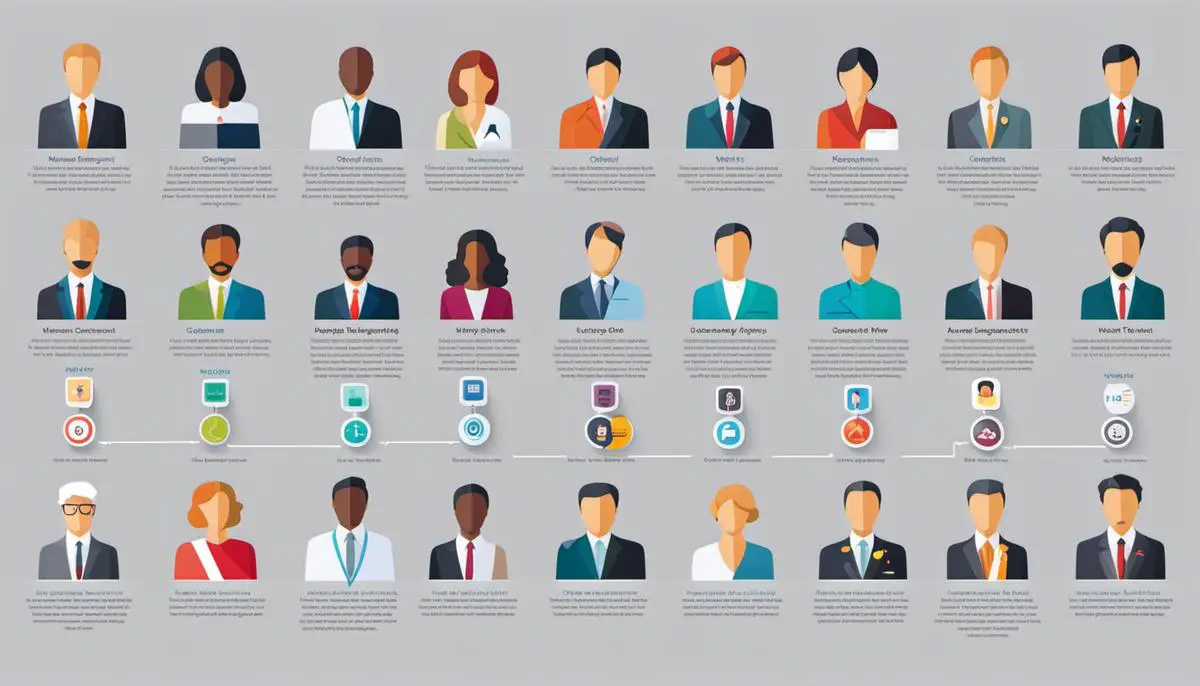In the digital age, the essence of promoting a business effectively resonates in the ability to create compelling content for your website. It’s no longer just about selling products or services; it’s about providing valuable information that not only draws consumers in but also encourages them to stay – leading them right to the doorstep of your business. The journey towards creating effective content starts with understanding your audience intimately, then leveraging this understanding in every aspect of your content creation, including SEO, storytelling techniques and content strategy.
Understanding Your Audience
Knowing Your Audience
Identifying and understanding your target audience is a fundamental step in creating compelling content for your business website. This can involve gathering demographic and psychographic data, observing audience behavior and preferences, as well as envisaging their needs and desires.
Conducting Demographic Research
Demographic research is crucial in determining who your customers are from a statistical perspective. Demographic data to gather includes age, location, gender, income, education level, marital status, occupation, and ethnicity. This data can be collected through surveys, analysis of customer data, online research, and social media analytics.
Conducting Psychographic Research
Psychographic research dives deeper into the motivations and personality traits of your audience. It includes aspects such as interests, attitudes, values, behaviors, and lifestyle choices. This kind of information can be gathered through more in-depth surveys, focus groups, and through analyzing user engagement and feedback on your website and social media platforms.
Understanding Audience Behavior and Preferences
Another critical research aspect involves identifying your audience’s behavior and preferences. This might involve examining their buying behavior, style of communication, spending habits, popular social media platforms, preferred content formats (video, blogs, podcasts, etc.), and frequent challenges they encounter in relation to your industry or product.
Tailoring Your Content
Once you have a clear understanding of who your audience is, tailor your content to suit their interests, preferences, and needs. This could mean using certain language or jargon, addressing particular problems or interests, or using specific content formats. Stay consistent with this tailored content to build trust and assert your brand’s personality.
Using Customer Feedback to Refine Your Content
Always be open to customer feedback and use it to refine your content strategy. This means actively encouraging comments, reviews, and suggestions from your audience. Monitor this feedback, make adjustments as necessary, ensure your content continues to be relevant and useful to your audience.
Using Analytics to Understand Audience Behavior
To understand how your audience consumes your content, leverage analytics tools available on platforms such as Google, social media, and your website. These provide valuable data about how users interact with your content – what they click on, how much time they spend, what they share, and more.
By understanding your audience’s demographics, psychographics, behavior, preferences, and how they consume your content, you can create compelling and targeted content that resonates with them. It enhances your rapport with your customers and makes your business more relatable and engaging.

Photo by anniespratt on Unsplash
SEO and Keyword Research
Understanding SEO
SEO, or Search Engine Optimization, is a vital digital marketing strategy that improves your website’s visibility in search engine results. By understanding and optimizing SEO, you can draw more traffic to your site, which can lead to increased customer engagement and greater business revenue.
Keyword Research
Keyword research is an essential part of SEO. It involves finding the words and phrases people use when searching for products or services like yours online. Consider the following steps when conducting keyword research:
- List Relevant Topics: Think about the topics that are most relevant to your business. What is the niche of your business? What topics should you be ranking for?
- Find Keywords for Each Topic: Once you have your topic list, find keywords related to each topic. These could be the phrases or words that customers use to describe your products or services.
- Use Keyword Research Tools: For deeper keyword insights, use online tools like Google Keyword Planner or SEMrush. These tools provide data about the popularity and competitiveness of specific keywords.
- Analyze the Competition: Look at the keywords your competitors are using. This can help you discover additional keywords, understand market demand, and stay competitive.
Metadata
Metadata is the information that instructs search engines what your webpage content is about. It includes page title, meta description, and meta tags. Optimize your metadata to increase the relevancy of your content to specific queries.
- Page Title: The page title, also known as the “title tag,” is the headline that a search engine displays on its results page. It should accurately describe the page’s content and include relevant keywords.
- Meta Description: Meta descriptions are short overviews of your web page content that appear under the title in search results. Make sure your descriptions are concise, appealing and contain keywords to attract users and search engines.
- Meta Tags: These are words or phrases that define what your content is about. While not visible on the page itself, search engines use meta tags to categorize your content. Include your most important keywords in your meta tags.
Link-Building Strategies
Link building is an important aspect of SEO. It involves acquiring hyperlinks from other websites to your own, as search engines use links to crawl the web and establish a page’s credibility.
- Create High-Quality Content: People link to valuable content. By creating relevant, informative, and engaging content, you encourage others to link to your pages.
- Guest Blog on Reputable Sites: Guest blogging can help broaden your audience and generate inbound links. Write informative posts for popular blogs in your industry.
- Use Social Media: Sharing your content on social media platforms can attract more traffic and generate more links to your website.
Remember, maintaining quality and consistency is key while incorporating SEO elements into your content. These steps, with focused effort and analysis, can help improve your business website’s visibility online.

Content Creation Basics
Mastering Storytelling Techniques
First and foremost, successful content lies in the art of storytelling. Connect with your audience on a personal level by weaving narratives into your content. Use anecdotes, user experiences, or case examples to illustrate your point. Employ elements like a beginning, middle, and end, combined with characters and conflict, making your content more relatable and engaging.
Establishing a Unique Voice and Tone
Creating a distinctive voice and tone for your content is crucial. This is the way you ‘speak’ to your audience and is an extension of your brand’s personality. You should consistently carry your voice across all your content—whether formal or informal, professional or friendly—based on your target audience. The tone of your content should also adapt to the nature of the message at hand, ranging from enthusiastic and motivational to empathetic or urgent.
Creating Varied Content Types
Different types of content appeal to different audience segments. Harness this by creating a variety of content types like blog posts, podcasts, videos, infographics, eBooks, white papers, and social media updates. Long-form blog posts are perfect for deep dives into topics, while infographics are useful for presenting data in a visual, easily digestible format. Videos can be best for how-to guides or product demos, and podcasts are great for providing your audience with content they can consume on the go.
Grammar, Coherence, and Structure
Always prioritize high-quality writing in your content. This means proper grammar, clear coherence, logical structure, and the right use of vocabulary. Use language that your audience can easily follow and understand, avoiding jargon and unnecessarily complex sentences. Make sure the text is broken up into digestible chunks with use of subheadings, bullet points and short paragraphs. Good structure gives flow to your content and helps guide the reader seamlessly through the narrative.
Optimum Use of SEO
The incorporation of SEO (Search Engine Optimization) enhances the visibility of your content. Identify and utilize keywords relevant to your content within the body of your text and meta descriptions. Remember that writing for search engines shouldn’t undermine the quality of your content. SEO should serve as a guide rather than a constraint in your content creation.
Regular Content Updates
Finally, updating your website consistently with fresh content is essential. Regular updates signal both your audience and web search engines that your site is active and that they should keep checking back for more content. Moreover, the more quality content you produce, the more chances you have to engage your audience, build trust, and generate conversions for your business.

Content Strategy and Marketing
Content Strategy and Marketing
Creating compelling content is the first stage in content strategy and marketing. The next phase includes using this content to meet your business goals. Let’s delve into steps for successful content strategy and marketing for your business website.
Planning and Scheduling
Your first step in content marketing is to devise a detailed plan. This plan should clearly define your target audience, business objectives, brand voice, and types of content you want to create. Once you have these elements outlined, create a content calendar. A content calendar helps in organizing and scheduling your content distribution. By doing so, you can ensure a continuous flow of engaging content which resonates with your audience.
Content Promotion
Next, you need to focus on content promotion. Use different mediums for content promotion like social media, newsletters, and blogs. Optimizing your content with relevant keywords will also be beneficial for it to rank high in search engine results. This, in turn, will increase its visibility, drawing in more customers to your website.
Distribution Channels
Identifying the right distribution channels is equally important. Choose the channels your target audience uses the most. Social media platforms, email marketing, SEO, and company blogs are popular channels for content distribution. Using a mix of these channels will ensure maximum reach for your content.
Analyzing Content Performance
Lastl##y, measure the performance of your content. You can use tools like Google Analytics for this purpose. Measure metrics like engagement rate, click-through rate (CTR), and conversion rate to assess how your content is performing. This data will help you understand what is working and what isn’t, and guide you in making necessary amendments to improve your content’s performance.
Remember, consistently creating and sharing high-quality content is an ongoing process. Stay connected with your audience, keep updating your content strategy based on the analytics and always strive to provide value through your content.

Building the foundation of a strong online presence relies fundamentally on the creation and strategic use of compelling content. As you continue to tailor your content to the needs and wants of your audience, enhance its visibility through SEO, employ captivating storytelling methods and strategize your content marketing, you’re not just creating content – you are crafting a digital pathway that guides consumers right to your business. By doing so, you’re not only connecting with your audience on a deeper level but also encouraging a sense of trust that eventually leads to business growth and success.
